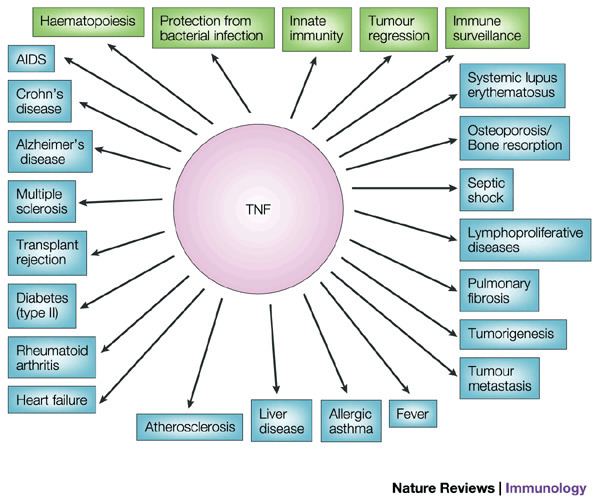The tumor necrosis factor (TNF) superfamily refers to a superfamily of cytokines that can cause cell death (apoptosis).
The first two members of the family to be identified were:
Tumor necrosis factor (TNF), formerly known as TNFα or TNF alpha, is the best-known member of this class. TNF is a monocyte-derived cytotoxin that has been implicated in tumor regression, septic shock, and cachexia. The protein is synthesized as a prohormone with an unusually long and atypical signal sequence, which is absent from the mature secreted cytokine. A short hydrophobic stretch of amino acids serves to anchor the prohormone in lipid bilayers. Both the mature protein and a partially processed form of the hormone can be secreted after cleavage of the propeptide.Lymphotoxin-alpha, formerly known as Tumor necrosis factor-beta (TNF-β), is a cytokine that is inhibited by interleukin 10.Nineteen proteins have been identified as part of the TNF family on the basis of sequence, functional, and structural similarities. They include:
Tumor necrosis factor (TNF) (also known as cachectin or TNF alpha) is a cytokine that has a wide variety of functions. It can cause cytolysis of certain tumor cell lines; it is involved in the induction of cachexia; it is a potent pyrogen, causing fever by direct action or by stimulation of interleukin-1 secretion; it can stimulate cell proliferation and induce cell differentiation under certain conditions.Lymphotoxin-alpha (LT-alpha) and lymphotoxin-beta (LT-beta), two related cytokines produced by lymphocytes that are cytotoxic for a wide range of tumor cells in vitro and in vivo.T cell antigen gp39 (CD40L), a cytokine that seems to be important in B-cell development and activation.CD27L, a cytokine that plays a role in T-cell activation. It induces the proliferation of co-stimulated T cells and enhances the generation of cytolytic T cells.CD30L, a cytokine that induces proliferation of T cells.FASL, a cell surface protein involved in cell death.4-1BBL, an inducible T cell surface molecule that contributes to T-cell stimulation.OX40L, a cell surface protein that co-stimulates T cell proliferation and cytokine production.TNF-related apoptosis inducing ligand (TRAIL), a cytokine that induces apoptosis.All these cytokines seem to form homotrimeric (or heterotrimeric in the case of LT-alpha/beta) complexes that are recognized by their specific receptors. Strong hydrogen bonds between the monomers stabilize the tertiary structure. One such example is the Asn34-Arg82 hydrogen bond in the M. musculus TNF alpha. The PROSITE pattern for this family is located in a beta-strand in the central section of the protein that is conserved across all members.
All members of the TNF family, with the exception of the secreted lymphotoxin and a proliferation-inducing ligand (APRIL), are type II transmembrane proteins that protrude from immune cells. Such membrane-bound TNF ligands frequently signal back to the immune cells when they contact and bind their cognate receptors on other cells.
Human proteins containing this domain include:
CD40LG (TNFSF5); CD70 (TNFSF7); EDA; FASLG (TNFSF6); LTA (TNFSF1); LTB (TNFSF3);TNFTNFSF4 (OX40L); TNFSF8 (CD153); TNFSF9; TNFSF10 (TRAIL); TNFSF11 (RANKL); TNFSF12 (TWEAK); TNFSF13; TNFSF13B; TNFSF14; TNFSF15; TNFSF18;
